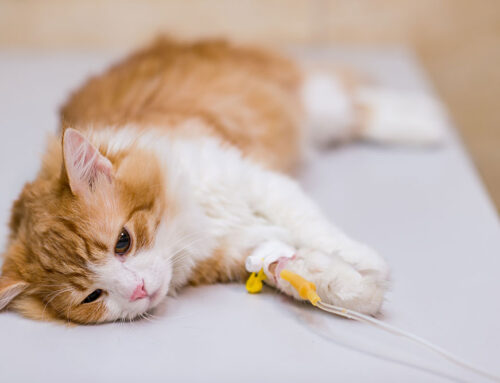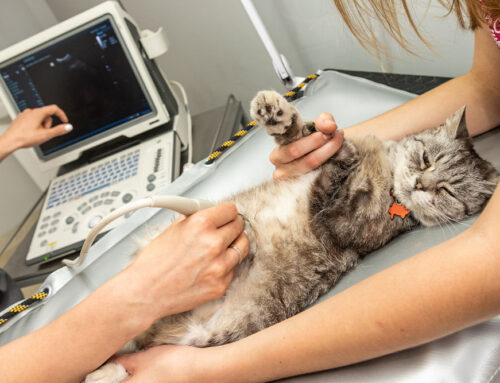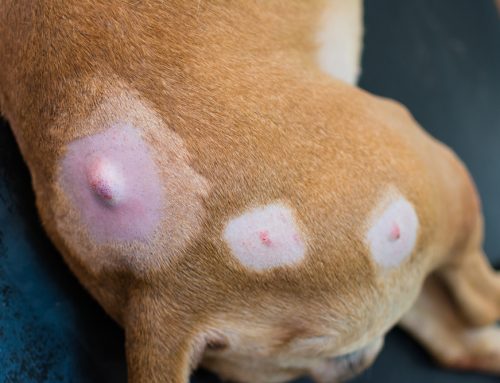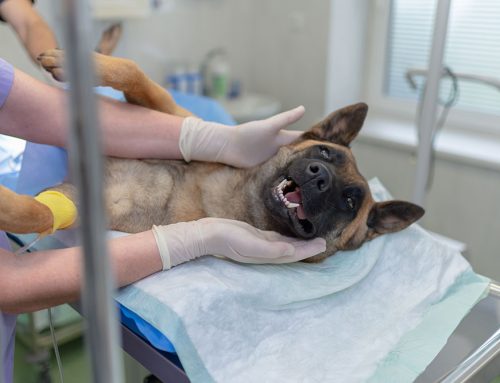Candy hearts, Cupid-filled stores, and pink decor tell us Valentine’s Day is just around the corner. February is also National Pet Dental Health Month and the perfect time to give your pet’s smile extra love and attention. Our four-legged companions often express their love through purrs, wagging tails, and slobbery kisses. However, if you have ever turned away your pet’s affection because of their smelly breath, you are not alone. While many pet owners think their pet’s bad breath is normal, it’s often the first sign of periodontal disease. Dental issues are among the most commonly diagnosed problems in pets, and more than 80% of dogs and cats will have some degree of periodontal disease by the time they are 3 years old. Our Burlington Veterinary Center team wants to ensure you enjoy kissing your pet for years to come, so follow these four tips for managing their dental health.
#1: Learn to recognize periodontal disease signs in pets
Recognizing the problem is the first step in protecting your pet’s teeth from more painful, serious issues. Like people, pets with periodontal disease have an increased risk for problems with their heart, liver, and kidneys, but it can be challenging to know when there is a problem with their teeth because pets, especially cats, are masters at masking signs of illness. In many cases, foul or bad breath is the first and only clue a pet is suffering from periodontal disease. However, other signs can include:
- Pain when the mouth or face is touched
- Bleeding from the mouth
- Blood on chew toys
- Behavior changes, or head and face shyness
- Dropping food from the mouth while eating
- Removing food from the bowl and eating off the floor
- Irritability, or increased hiding in cats
- Decreased appetite
- Abnormal or difficulty chewing
- Excessive drooling
- Refusal or reluctance to take hard treats
- Swollen or red gums
- Swelling around the mouth or cheeks
- Nasal discharge
#2: Understand periodontal disease risks for pets
Periodontal disease can affect a pet’s longevity and overall quality of life, so owners must understand the associated risks. While pets of any age or breed are at risk for painful dental problems, some, including small-breed dogs, brachycephalic dogs, pets with a misaligned bite, and cats with underlying infectious diseases like Feline Leukemia Virus, have an increased risk for periodontal disease.
Periodontal disease develops from the buildup of plaque on your pet’s teeth. Following a meal, oral bacteria form plaque on the teeth above and below the gumline. Plaque buildup, in turn, leads to gum inflammation or gingivitis, and pockets between the teeth and gums or periodontitis. Without treatment, pets may suffer tooth loss, painful abscesses, or bacterial infections that can spread to their liver, heart, or kidneys.
#3: Schedule your pet for an anesthetic dental cleaning
A professional veterinary dental cleaning under general anesthesia is the safest, least stressful, and pain-free way to evaluate, thoroughly clean, and treat your pet’s teeth. Our Burlington Veterinary Center dental packages are an affordable way to ensure your pet’s oral health care needs are addressed. The dental exam and cleaning include a preanesthetic examination to ensure your pet is healthy enough to process the anesthetic agents, as well as:
- Preanesthetic sedation and gas anesthesia
- Intravenous (IV) fluids to support your pet’s organs and blood pressure during the procedure
- Specialized blood pressure and heart monitors
- Specialized warming pads and blankets to maintain body temperature
- A dedicated dental technician to monitor your pet
- Digital before and after dental X-rays to examine teeth below the gumline
- Thorough scaling and cleaning of the teeth and gums with specialized dental tools, including an ultrasonic scaler
- Gentle probing around each tooth to look for pockets or infection
- Polishing with a fluoride-infused polish to prevent plaque buildup
- Extraction of loose or damaged teeth
#4: Start a home dental cleaning routine for your pet

Plaque begins to build up on your pet’s teeth 24 hours after a professional dental cleaning. That means a home dental cleaning routine combined with regular veterinary visits is the most effective way to prevent your pet from developing severe periodontal disease or associated illnesses. Brushing your pet’s teeth twice daily is the gold standard, but a minimum of three times a week is also beneficial. Patience is essential when starting a brushing routine, and it can take time for your pet to accept regular brushing. Follow these guidelines for the best results:
- Use a pet-safe toothpaste approved by the Veterinary Oral Health Council (VOHC).
- Start by offering a small amount of toothpaste on your finger so your pet gets used to the taste, and gently rub the paste over their gums.
- Choose a pet-specific toothbrush designed to fit comfortably in their mouth.
- Provide ample praise during and after brushing so it is a positive experience for your pet.
Bad breath isn’t pleasant for anyone and could be a sign your furry pal has painful periodontal disease. Contact our Burlington Veterinary Center team if you have any questions about your pet’s teeth or to schedule an oral health evaluation.







Leave A Comment